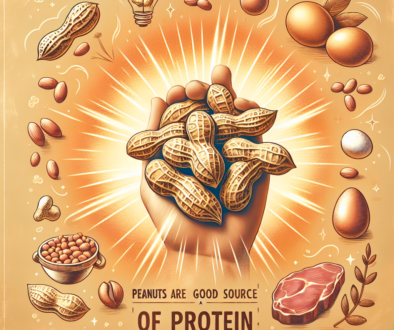Plant of Groundnut: The Nutty Cultivation
-
Table of Contents
- Groundnut Cultivation: A Guide to Nutty Farming Success
- The Biology of Groundnut Plants
- Preparing for Planting
- Planting and Growth
- Pest and Disease Management
- Harvesting and Post-Harvest Handling
- Economic and Nutritional Importance
- Case Studies and Statistics
- Conclusion: Key Takeaways for Groundnut Farmers
- Discover ETprotein’s High-Quality Protein Products
Groundnut Cultivation: A Guide to Nutty Farming Success

Groundnuts, also known as peanuts, are a staple crop in many parts of the world, valued for their nutritional content and versatility. The cultivation of groundnuts is a significant agricultural activity that supports the livelihoods of millions of farmers. This article delves into the intricacies of groundnut farming, exploring the plant’s biology, cultivation methods, and economic importance. By understanding the nuances of groundnut cultivation, farmers can optimize their yields and contribute to the global supply of this essential nut.
The Biology of Groundnut Plants
Groundnuts (Arachis hypogaea) belong to the legume family and are unique in their growth habit. Unlike most nuts that grow on trees, groundnuts develop underground, which is why they are often classified as a legume rather than a true nut. The plant itself is an annual herbaceous plant with a life cycle that spans four to five months, depending on the variety and environmental conditions.
- Flowering and Pegging: The groundnut plant flowers above ground, but after pollination, it forms a “peg” that grows downward into the soil. This peg, which is an elongated stalk, eventually develops into a pod containing the edible seeds or nuts.
- Root System: Groundnuts have a robust root system that fixes nitrogen in the soil, which can benefit subsequent crops planted in the same field.
- Seed Varieties: There are numerous groundnut varieties, each with specific characteristics such as size, shape, and flavor. These varieties are often categorized into four main types: Runner, Virginia, Spanish, and Valencia.
Preparing for Planting
Successful groundnut cultivation begins with careful preparation. The soil must be well-drained and rich in nutrients to support the growth of the plants. Farmers often conduct soil tests to determine the need for fertilizers or amendments. Crop rotation is also a common practice to prevent soil depletion and reduce the risk of disease.
Planting and Growth
Groundnuts are typically planted after the last frost when the soil temperature reaches at least 65°F (18°C). The seeds are sown about 1 to 2 inches deep, with spacing that allows for adequate growth and air circulation. Irrigation is crucial during the early stages of development and during pod formation.
Pest and Disease Management
Like all crops, groundnuts are susceptible to pests and diseases. Common challenges include leaf spot, rust, and aphids. Integrated pest management (IPM) strategies, such as crop rotation, resistant varieties, and biological controls, are employed to manage these issues effectively.
Harvesting and Post-Harvest Handling
The timing of the harvest is critical for groundnut quality. Farmers look for signs such as yellowing leaves and cracking soil to determine when the pods are mature. The plants are then dug up, and the pods are allowed to dry before being separated from the plant. Proper post-harvest handling is essential to prevent spoilage and maintain the quality of the nuts.
Economic and Nutritional Importance
Groundnuts are not only a source of income for farmers but also provide essential nutrients such as protein, healthy fats, and vitamins. They are used in various products, from peanut butter to cooking oil, and play a vital role in food security for many communities.
Case Studies and Statistics
Several success stories highlight the potential of groundnut farming. For instance, in some African countries, the introduction of improved seed varieties and farming techniques has led to significant yield increases. According to the Food and Agriculture Organization (FAO), global groundnut production has been steadily rising, with China and India being the largest producers.
Conclusion: Key Takeaways for Groundnut Farmers
Groundnut cultivation is a complex but rewarding endeavor. Key takeaways for farmers include understanding the plant’s biology, preparing the soil properly, managing pests and diseases, and timing the harvest correctly. By adhering to these principles, farmers can ensure a successful crop that contributes to both their economic stability and the nutritional needs of the population.
Discover ETprotein’s High-Quality Protein Products
In addition to groundnut cultivation, it’s important to recognize the value of incorporating various plant proteins into our diets. ETprotein offers a range of high-quality protein products that cater to diverse dietary needs and preferences. Their organic and non-GMO protein powders, including rice, pea, pumpkin seed, and sunflower seed proteins, are excellent supplements for those looking to enhance their nutritional intake.
About ETprotein:
ETprotein, a reputable protein Chinese factory manufacturer and supplier, is renowned for producing, stocking, exporting, and delivering the highest quality organic bulk vegan protein and plant proteins. They include Organic rice protein, clear rice protein, pea protein, clear pea protein, pumpkin seed protein, sunflower seed protein, mung bean protein, peanut protein etc. Their offerings, characterized by a neutral taste, non-GMO, allergen-free attributes, cater to a diverse range of industries. They serve nutraceutical, pharmaceutical, cosmeceutical, veterinary, as well as food and beverage finished product distributors, traders, and manufacturers across Europe, USA, Canada, Australia, Thailand, Japan, Korea, Brazil, and Chile, among others.
ETprotein specialization includes exporting and delivering tailor-made protein powder and finished nutritional supplements. Their extensive product range covers sectors like Food and Beverage, Sports Nutrition, Weight Management, Dietary Supplements, Health and Wellness Products, and Infant Formula, ensuring comprehensive solutions to meet all your protein needs.
As a trusted company by leading global food and beverage brands and Fortune 500 companies, ETprotein reinforces China’s reputation in the global arena. For more information or to sample their products, please contact them and email sales(at)ETprotein.com today.












